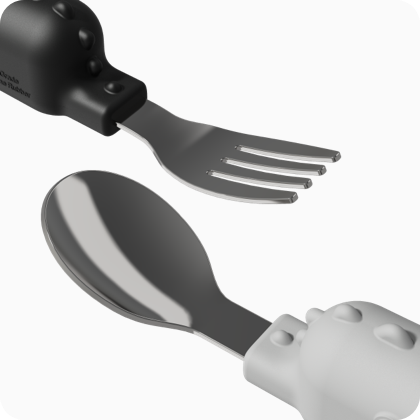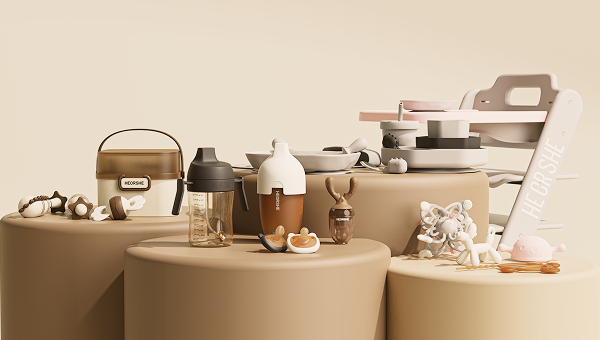As any parent knows, introducing solid foods to a baby is an exciting milestone, but it comes with its own set of challenges—mess, resistance, and the quest for safe, reliable feeding products. Among all the options available on the market today, baby tableware made of silicone has quickly become a standout choice for safety, durability, and functionality.
In this comprehensive guide, we'll explore the evolution of baby tableware, why silicone tableware is winning over modern families, how to choose the best products (especially silicone dinner plates), and offer tips for safe, stress-free mealtimes.
The Evolution of Baby Tableware
Historically, feeding infants involved little more than modified adult utensils and dishes. Early parents used ceramic or metal bowls and spoons, many of which were heavy, breakable, and completely unsuitable for small hands and mouths. As time progressed, plastic became the go-to material. It was lightweight and colorful, but concerns soon arose over the safety of BPA, phthalates, and microplastics, especially when heated.
The evolution of baby tableware has mirrored advances in material science and parenting philosophy. Today, there's a strong focus on child development, safety, sustainability, and promoting autonomy through baby-led weaning (BLW). As a result, manufacturers have pivoted toward more innovative materials, particularly silicone, to meet the needs of both babies and parents.

What Is Silicone Tableware and Why Is It Popular?
Silicone tableware is made from food-grade silicone, a synthetic material known for its flexibility, resilience, and safety. Unlike plastic, silicone doesn't degrade with heat or repeated washing and does not release harmful chemicals.
The popularity of silicone tableware has skyrocketed in recent years due to several core advantages:
- Chemical Safety: Food-grade silicone is BPA-free and non-toxic, making it ideal for infants.
- Flexibility: It can bend without breaking, making it safe for little hands.
- Versatility: Silicone items are microwave-safe, dishwasher-safe, freezer-safe, and oven-safe.
- Comfort: Its soft, rubber-like feel is gentle on delicate gums.
These qualities make silicone not only practical but also a long-term investment in your child's feeding journey.
Benefits of Using Silicone Dinner Plates for Babies
Silicone dinner plates have emerged as a staple in the modern highchair for good reason. They combine function, safety, and child-friendly design to support positive mealtime habits.
1. Suction Base for Stability
Most silicone plates come with built-in suction bases that adhere securely to tables and highchair trays. This prevents flipping or sliding, reducing spills and frustration.
2. Divided Compartments
Many silicone dinner plates are sectioned into multiple compartments. This allows parents to introduce a variety of foods in one meal, supporting a balanced diet and sensory exploration.
3. Durable and Baby-Safe
The soft, flexible surface is not only comfortable but also safe for teething babies who like to chew on everything in sight.
4. Heat-Resistant
Silicone plates can go directly from fridge to microwave without risk. They stay cool to the touch, reducing the chances of burns.
5. Lightweight and Travel-Friendly
Silicone plates are easy to roll up and pack, making them perfect for travel, outings, and daycare.
Overall, silicone dinner plates offer unmatched convenience and peace of mind.
Key Features to Look for in Baby Tableware
When shopping for baby tableware, it's important to consider more than just appearance. Functional and safety features ensure that products are developmentally appropriate and long-lasting.
Material Safety
Always confirm that the tableware is made from 100% food-grade silicone or another approved non-toxic material. Look for BPA-free, PVC-free, and phthalate-free labels.
Ergonomic Design
Choose utensils with rounded edges, bowls with curved sides for easy scooping, and plates with suction bases for stability.
Dishwasher and Microwave Safe
Busy parents benefit from tableware that can be quickly sanitized or reheated.
Visual Appeal
Bright colors and playful shapes encourage kids to engage with their meals. Designs like animal faces or cars can make mealtime fun.
Growth Adaptability
Select pieces that grow with your child—like a plate that serves both infants and toddlers or utensils with removable silicone handles.
Popular Types of Silicone Tableware
There is a wide variety of silicone tableware available, each designed to meet specific feeding needs.
Silicone Suction Bowls
These bowls are ideal for soft foods and purees. The suction base keeps them in place, and some include lids for storage.
Silicone Dinner Plates
Available in various shapes and sizes, they often feature multiple compartments and a strong suction base to minimize mess.
Silicone Bibs
These bibs are waterproof, easy to clean, and come with food-catching pockets that reduce waste.
Silicone Cups and Utensils
Silicone training cups and soft-tipped utensils help babies learn how to drink and eat independently without risk of injury.
Silicone Placemats
Some placemats are integrated with plate compartments and offer full surface coverage to protect dining tables or highchair trays.
Cleaning and Maintaining Silicone Dinner Plates
Proper maintenance extends the life of your silicone dinner plates and ensures hygienic use.
Everyday Cleaning
Most silicone plates are dishwasher safe. For manual washing, warm water and dish soap will suffice.
Deep Cleaning
If plates develop stains or odors, try soaking them in a solution of baking soda and warm water, or vinegar and lemon juice.
Sterilization
Silicone can be safely boiled or run through a baby bottle sterilizer. This is especially helpful during the early months when hygiene is paramount.
Storage
Silicone plates can be stored flat or rolled to save space, perfect for minimalist households or travel.
Safety Standards and Certifications
Reputable baby tableware manufacturers ensure their products meet or exceed international safety standards.
Certifications to Look For:
- FDA-Approved (U.S.): Indicates food-grade compliance.
- LFGB Certification (Europe): A stricter test for food safety.
- BPA-Free Labeling: Guarantees the absence of harmful plastics.
- CPSIA Compliance: Verifies that the product meets U.S. child safety laws.
Always check product descriptions and packaging to confirm compliance with these standards.
![]()
Transitioning to Tableware: Tips for Parents
Introducing baby tableware is a milestone that supports independence and sensory learning.
Start Slowly
Begin with a small, soft spoon and a suction bowl. Offer finger foods alongside to build motor skills.
Encourage Exploration
Let your baby touch, hold, and play with the tableware. This builds familiarity and reduces resistance.
Set Expectations
Don’t expect mess-free meals right away. Use a silicone mat underneath to catch spills and encourage self-feeding.
Consistency Is Key
Use the same plate and utensils daily to help your baby associate them with mealtime.
Sustainable and Eco-Friendly Aspects
Compared to disposable or low-quality plastic alternatives, silicone tableware offers a more sustainable choice.
Environmental Benefits:
- Durability: Withstands wear and tear, reducing the need for replacements.
- Non-Toxic Production: Silicone manufacturing typically uses fewer harmful chemicals than plastic.
- Recyclable: Some recycling centers accept silicone, and it breaks down more safely than plastic.
- Multi-Purpose Use: Many silicone items serve as bowls, storage, and even baking containers.
Eco-conscious families often prefer silicone for its low-waste, high-function profile.
Buying Guide: What to Avoid and What to Prioritize
Not all baby tableware meets the same standards. Here are some do’s and don'ts:
Avoid:
- Items with no clear safety labeling
- Plastic or melamine dishes that degrade over time
- Sharp edges or components that can break off
Prioritize:
- Verified 100% food-grade silicone products
- Tableware with suction bases and divided sections
- Brands with transparent manufacturing practices
Investing in quality upfront saves time, money, and worry in the long run.
Conclusion
Choosing the right baby tableware is a blend of safety, functionality, and aesthetics. Silicone tableware, and particularly silicone dinner plates, offer the best of all worlds: safety for your baby, ease of use for you, and long-lasting value for your household.
Whether you’re a first-time parent or adding to your growing family, investing in high-quality silicone dinner plates can turn mealtime from a daily battle into a developmental milestone. With the right tools, every meal becomes an opportunity for exploration, bonding, and growth.


